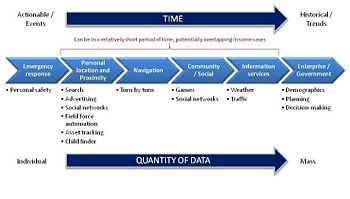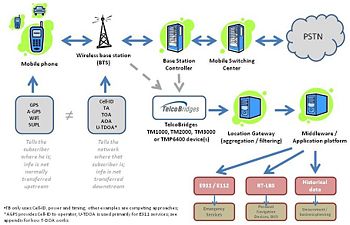Location-based services
(spelling mistake) |
(→TelcoBridges and Location-based services: minor edit) |
||
| (6 intermediate revisions by 2 users not shown) | |||
| Line 4: | Line 4: | ||
The location component can be derived in one of three ways: | The location component can be derived in one of three ways: | ||
| − | * The first is driven via [[GPS]] data captured by a GPS-enabled mobile handset or other device. Unless the user has a data plan, the GPS location data stays resident on the device. It is not transmitted via channels such as [[SMS]] back to the network operator and thus does not help the | + | * The first is driven via [[GPS]] data captured by a GPS-enabled mobile handset or other device. Unless the user has a data plan, the GPS location data stays resident on the device. It is not transmitted via channels such as [[SMS]] back to the network operator and thus does not help the operator locate the subscriber. |
* The second is through the explicit entry of position by the user via a device-resident application. This may be in combination with GPS data but with additional contextual information provided by the user. This kind of data is transmitted over the data plan but usually bypasses the operator; instead, a third-party site such as [http://www.facebook.com Facebook], [http://www.playfoursquare.com/ FourSquare], [http://www.opentable.com OpenTable], or other such services. | * The second is through the explicit entry of position by the user via a device-resident application. This may be in combination with GPS data but with additional contextual information provided by the user. This kind of data is transmitted over the data plan but usually bypasses the operator; instead, a third-party site such as [http://www.facebook.com Facebook], [http://www.playfoursquare.com/ FourSquare], [http://www.opentable.com OpenTable], or other such services. | ||
*The third approach is to derive the position of the handset via timing and signal strength information captured via the mobile network. This can be achieved via such approaches as [http://en.wikipedia.org/wiki/Cell_of_origin_%28telecommunications%29 Cell Identification], [http://en.wikipedia.org/wiki/Time_of_arrival Time of Arrival (TOA)], [http://en.wikipedia.org/wiki/Angle_of_Arrival Angle of Arrival (AOA)], [http://en.wikipedia.org/wiki/U-TDOA Uplink-Time Difference of Arrival (U-TDOA)], [http://www.polariswireless.com/ wireless location signatures], and others. | *The third approach is to derive the position of the handset via timing and signal strength information captured via the mobile network. This can be achieved via such approaches as [http://en.wikipedia.org/wiki/Cell_of_origin_%28telecommunications%29 Cell Identification], [http://en.wikipedia.org/wiki/Time_of_arrival Time of Arrival (TOA)], [http://en.wikipedia.org/wiki/Angle_of_Arrival Angle of Arrival (AOA)], [http://en.wikipedia.org/wiki/U-TDOA Uplink-Time Difference of Arrival (U-TDOA)], [http://www.polariswireless.com/ wireless location signatures], and others. | ||
| Line 14: | Line 14: | ||
== TelcoBridges and Location-based services == | == TelcoBridges and Location-based services == | ||
| − | The TelcoBridges [[Tmonitor]] family of products ([[TM1000 | + | The TelcoBridges [[Tmonitor]] family of products ([[TM1000]] for T1/E1/J1 networks; the [[TM3000]] for STM-1 networks) provide a high-performance network monitoring solution that enables '''aggregation of subscriber location''', providing a foundation for location-based services (LBS) such as proximity-based notification, real-time automobile traffic reports, and the ability to alert roaming customers by [[SMS]]. |
[[Image:Lbs-schematic.jpg|thumb|350px|Schematic showing capture of subscriber positional data from the network using TelcoBridges Tmonitor devices]] | [[Image:Lbs-schematic.jpg|thumb|350px|Schematic showing capture of subscriber positional data from the network using TelcoBridges Tmonitor devices]] | ||
| − | Tmonitor devices perform non-intrusive, full-duplex monitoring, filtering, and analysis of traffic such as [[SS7]] and [[ISDN]] signaling, [[HDLC]] frames, as well as raw traffic on T1/E1/JI or STM-1 interfaces at line speed, providing up to 100% packet capture. It features highly configurable on-board packet filters so that only relevant information is captured from traffic streams and stored | + | Tmonitor devices perform non-intrusive, full-duplex monitoring, filtering, and analysis of traffic such as [[SS7]] and [[ISDN]] [[Signaling protocols|signaling]], [[HDLC]] frames, as well as [[Raw traffic|raw traffic]] on T1/E1/JI or [[STM-1]] interfaces at line speed, providing up to 100% packet capture. It features highly configurable on-board packet filters so that only relevant information is captured from traffic streams and stored. |
Unlike software-based solutions running on the base station controller, Tmonitor devices impose no additional overhead on the core network equipment. Unlike a hardware probe, Tmonitor creates no additional latency and therefore no performance hit. | Unlike software-based solutions running on the base station controller, Tmonitor devices impose no additional overhead on the core network equipment. Unlike a hardware probe, Tmonitor creates no additional latency and therefore no performance hit. | ||
| − | As of July 2009, Tmonitor devices in place at one mobile carrier | + | As of July 2009, Tmonitor devices in place at one mobile carrier are capturing signaling traffic and handset positional data from over 500 base station controllers representing over 15 million mobile users and growing. This service provider has then been able to turn around and monetize this data to a third-party. |
| − | '''One important note:''' The very same Tmonitor hardware in place at a service provider used to provide location-based services can be used to perform [[Network monitoring|network monitoring]] activities and respond to [[Lawful intercept|lawful intercept]] mandates. | + | '''One important note:''' The very same Tmonitor hardware in place at a service provider used to provide location-based services can be used to perform [[Network monitoring|network monitoring]] activities and respond to [[Lawful intercept|lawful intercept]] mandates. This allows service providers to maximize their investment by achieving additional business objectives. |
[[category:Glossary]] | [[category:Glossary]] | ||
Latest revision as of 10:35, 7 April 2014
Location-based services refers to value-added services that have a location-based component. These can be such things as location-specific traffic reports, vehicle and personnel tracking, location-specific advertising, social network applications and others.
The location component can be derived in one of three ways:
- The first is driven via GPS data captured by a GPS-enabled mobile handset or other device. Unless the user has a data plan, the GPS location data stays resident on the device. It is not transmitted via channels such as SMS back to the network operator and thus does not help the operator locate the subscriber.
- The second is through the explicit entry of position by the user via a device-resident application. This may be in combination with GPS data but with additional contextual information provided by the user. This kind of data is transmitted over the data plan but usually bypasses the operator; instead, a third-party site such as Facebook, FourSquare, OpenTable, or other such services.
- The third approach is to derive the position of the handset via timing and signal strength information captured via the mobile network. This can be achieved via such approaches as Cell Identification, Time of Arrival (TOA), Angle of Arrival (AOA), Uplink-Time Difference of Arrival (U-TDOA), wireless location signatures, and others.
It is this third approach that is of interest to service providers. The impetus for the development of such technologies was in large part due to E911 regulations in the USA which compelled mobile service providers to be able to locate a subscriber's physical position to within a certain distance. That being said, the data provided by mobile devices can offer value over and above that of purely meeting E911 requirements. (See the diagram on the right for some examples.) Capturing, aggregating and then reselling that data to other application and service providers offers a means of further monetizing the activity of their subscribers.
The challenge for service providers has been to make sense of this flood of data in real-time while not impacting performance or quality of service to the customer. While many existing base station controllers can be configured to perform network monitoring for the purpose of location-based services, with the purchase of additional software from the equipment manufacturer, this comes at the cost of overall network performance since it requires resources normally dedicated to call connection and control.
TelcoBridges and Location-based services
The TelcoBridges Tmonitor family of products (TM1000 for T1/E1/J1 networks; the TM3000 for STM-1 networks) provide a high-performance network monitoring solution that enables aggregation of subscriber location, providing a foundation for location-based services (LBS) such as proximity-based notification, real-time automobile traffic reports, and the ability to alert roaming customers by SMS.
Tmonitor devices perform non-intrusive, full-duplex monitoring, filtering, and analysis of traffic such as SS7 and ISDN signaling, HDLC frames, as well as raw traffic on T1/E1/JI or STM-1 interfaces at line speed, providing up to 100% packet capture. It features highly configurable on-board packet filters so that only relevant information is captured from traffic streams and stored.
Unlike software-based solutions running on the base station controller, Tmonitor devices impose no additional overhead on the core network equipment. Unlike a hardware probe, Tmonitor creates no additional latency and therefore no performance hit.
As of July 2009, Tmonitor devices in place at one mobile carrier are capturing signaling traffic and handset positional data from over 500 base station controllers representing over 15 million mobile users and growing. This service provider has then been able to turn around and monetize this data to a third-party.
One important note: The very same Tmonitor hardware in place at a service provider used to provide location-based services can be used to perform network monitoring activities and respond to lawful intercept mandates. This allows service providers to maximize their investment by achieving additional business objectives.

